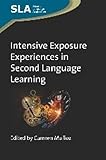Intensive Exposure Experiences in Second Language Learning / ed. by Carmen Muñoz.
Material type: TextSeries: Second Language AcquisitionPublisher: Bristol ; Blue Ridge Summit : Multilingual Matters, [2012]Copyright date: ©2012Description: 1 online resource (296 p.)Content type:
TextSeries: Second Language AcquisitionPublisher: Bristol ; Blue Ridge Summit : Multilingual Matters, [2012]Copyright date: ©2012Description: 1 online resource (296 p.)Content type: - 9781847698056
- 9781847698063
- Education, Bilingual
- Immersion method (Language teaching)
- Immersion method (Language teaching)
- Language and languages -- Study and teaching
- Second language acquisition -- Study and teaching
- LANGUAGE ARTS & DISCIPLINES / Linguistics / Psycholinguistics
- L2 language exposure
- L2 learning
- SLA
- Second Language Acquisition
- foreign language learning
- intensive instruction
- language exposure
- second language learning
- study abroad
- target language
- 418.0071 23
- P53.44 .I58 2012
- P53.44 I58 2012eb
- online - DeGruyter
| Item type | Current library | Call number | URL | Status | Notes | Barcode | |
|---|---|---|---|---|---|---|---|
 eBook
eBook
|
Biblioteca "Angelicum" Pont. Univ. S.Tommaso d'Aquino Nuvola online | online - DeGruyter (Browse shelf(Opens below)) | Online access | Not for loan (Accesso limitato) | Accesso per gli utenti autorizzati / Access for authorized users | (dgr)9781847698063 |
Browsing Biblioteca "Angelicum" Pont. Univ. S.Tommaso d'Aquino shelves, Shelving location: Nuvola online Close shelf browser (Hides shelf browser)

|

|

|

|

|

|

|
||
| online - DeGruyter Researching Language Teacher Cognition and Practice : International Case Studies / | online - DeGruyter Multilingualism and Creativity / | online - DeGruyter Bilingual Community Education and Multilingualism : Beyond Heritage Languages in a Global City / | online - DeGruyter Intensive Exposure Experiences in Second Language Learning / | online - DeGruyter Interpretation : Techniques and Exercises / | online - DeGruyter English-Medium Instruction at Universities : Global Challenges / | online - DeGruyter Integrating Multilingual Students into College Classrooms : Practical Advice for Faculty / |
Frontmatter -- Contents -- Contributors -- Acknowledgements -- Introduction -- Part 1: Theoretical Underpinnings of Intensive Learning -- 1. Is Intensive Learning Effective? Reflecting on the Results from Cognitive Psychology and the Second Language Acquisition Literature -- Part 2: Intensive Instruction -- 2. Intensive L2 Instruction in Canada: Why not Immersion? -- 3. Closing the Gap: Intensity and Proficiency -- 4. When Comprehensible Input is not Comprehensive Input: A Multi-dimensional Analysis of Instructional Input in Intensive English as a Foreign Language -- 5. What Language is Promoted in Intensive Programs? Analyzing Language Generated from Oral Assessment Tasks -- 6. Time and Amount of L2 Contact Inside and Outside the School – Insights from the European Schools -- Part 3: Learners’ Perceptions and Intensive Exposure -- 7. The Significance of Intensive Exposure as a Turning Point in Learners’ Histories -- 8. Change or Stability in Learners’ Perceptions as a Result of Study Abroad -- Part 4: Naturalistic Immersion -- 9. The Impact of Study Abroad and Age on Second Language Accuracy Development -- 10. Oral and Written Development in Formal Instruction and Study Abroad: Differential Effects of Learning Context -- 11. Differences in L2 Segmental Perception: The Effects of Age and L2 Learning Experience -- Index
restricted access online access with authorization star
http://purl.org/coar/access_right/c_16ec
This volume brings together studies dealing with second language learning in contexts that provide intensive exposure to the target language. In doing so, it highlights the role of intensive exposure as a critical distinctive characteristic in the comparison of learning processes and outcomes from different learning contexts: naturalistic and foreign language instruction, stay abroad and at home, and extensive and intensive instruction programmes. The different chapters represent a wide range of learning contexts and types of learning, as well as different approaches that yield much needed evidence on the role of context of acquisition in second language learning.
Mode of access: Internet via World Wide Web.
In English.
Description based on online resource; title from PDF title page (publisher's Web site, viewed 01. Dez 2022)


